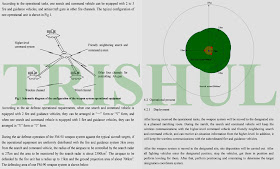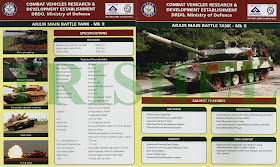Contrary to widespread speculation, the Indian
Army (IA) has not forsaken or given up on the Arjun Mk.2 main battle tank
(MBT). Instead, for the past four years, the IA’s Directorate General of
Mechanised Warfare has been overseeing a collective developmental effort
involving the DRDO, and the MoD-owned defence public-sector undertakings and
private-sector OEMs that will in the near future result in a fully-loaded 60-tonne MBT armed
with a 120mm smoothbore cannon while retaining the existing 1,400hp powerpack.
Under the supervision and guidance of the DRDO’s
Avadi-based Combat Vehicles Research & Development Establishment (CVRDE),
and with the help of the MoD’s Directorate General of Quality Assurance (DGQA)
and the IA’s Corps of Electronics & Mechanical Engineers (EME), a number of
key decisions have been to achieve a weight reduction of 8 tonnes in the
existing design of the 68-tonne Arjun Mk.1A MBTs, 118 of which are now in
delivery.
For starters, the baseline hull of the Arjun Mk.2 will no longer be
built with imported low-carbon, nickel-chromium-molybdenum rolled
homogeneous armor (RHA) steel, but with lighter high-nitrogen steel (HNS) whose production technology has been
mastered by the DRDO’s Hyderabad-based Defence Metallurgical Research Laboratory (DMRL) and has been transferred to Jindal Stainless Steel Ltd (Hisar). HNS will also be
used by TATA Motors Ltd for producing the 83 Kestrel 8 x 8 armoured personnel
carriers already on order.

HNS is produced in a four-step process: primary
melting of the steel can carried out in either induction furnace or electric
arc furnace by using appropriate raw materials; secondary melting can be
carryout in by nitrogen gas-purging in to the metal; under ladle refining,
ferro-nitrates are added to molten metal for obtaining final nitrogen content
in the alloy if it is required and hot-rolling is carried out in a single heat,
without reheating. Minimum percentage of reduction should not be less than 75%
of the slab thickness. To be placed in strategic locations in both the hull and
turret will be the DRDO-developed ‘Kanchan’ ceramics-based composite laminate armour tiles
as well as indigenously-built explosive reactive armour (ERA) tiles developed
by the DRDO’s High
Energy Materials Research Laboratory (HEMRL) on the front and sides of the hull and turret sections.

To ensure optimal weight budgeting during the
production engineering stage, the CVRDE has contracted Dynamatic Technologies Ltd,
which specialises in complex,
five-axis robotic machining, as well as in converting two-dimension paper
blueprints into three-dimension computer model that are more precise, and have
tighter tolerances. Digitising the drawings creates a baseline configuration
for greater accuracy. This in turn streamlines manufacturing, since conventional manufacturing
based on two-dimensional paper blueprints tend to leave tiny gaps between the
different components of an assembly that were filled with shims, leading to increased weight. But by digitising blueprints, those tiny gaps can be
entirely eliminated during the manufacturing process.

Under another weight-reduction exercise, the
CVRDE has contracted the Alicon Group for building all-aluminium road-wheels
and ventilators for not only the Arjun Mk.2, but also for the IA’s existing upgraded
T-72CIA medium tanks. They will replace the all-steel road-wheels built by Sundaram
Industries for the Arjun
Mk.1A. Similarly, TATA Power SED has been contracted for producing all-electric
turret stabilisation/traverse systems, in place of the existing
electro-hydraulic system.
Improvements have also been made to the 1,400hp powerpack (comprising the
MTU
838 Ka-501 diesel engine and RENK’s RK-304S gearbox) through the usage of
indigenously developed cooling systems.
However, the area that will see the Arjun Mk.2 emerging as a true new-generation
MBT will be vectronics, and in particular the battlespace management system
(BMS), which has been designed
to operate at the unit-level and below, and which will synthesise the battlespace
situational awareness picture for the unit commander, whether it be a
mechanised infantry regiment or an armoured regiment. The MBT and selected
infantrymen will thus become situational awareness platforms.

This project,
which was started only in 2008, has since been pushed at a faster rate as this
constitutes the cutting edge of the IA’s theatre-level Command Information Decision
Support System (CIDSS) programme that is being run by IA HQ’s Directorate of
Information Systems. The Future Infantry Soldier as a System (F-INSAS), which
is also a part of the CIDSS project, is being progressed by the IA HQ’s
Directorate of Infantry but will be a part of the overall BMS and battlespace
surveillance system (BSS) network of the IA.

The BSS and BMS are in turn being
integrated by IA HQ’s Directorate of Signals with other components of the fourth-generation
Tactical Command, Control, Communications and Information (TAC-C3I) system
through the CIDSS channel. Through the BMS and BSS the IA wants to provide a Divisional-level
command-and-control system spanning the entire tactical battle area (TBA)
spreading across individuals, detachments, combat platforms, sensors, sub-units,
units to the Brigade Commander/Regimental Commander; achieve faster reaction
capability and flexibility in command and control by providing information
automatically in the right place at the right time, thereby compressing the
OODA loop; provide a strong foundation for making decisions based on near-real
time situational awareness and battlespace transparency, providing consistent
and well-structured information, thereby enhancing the information handling
capability of commanders at all levels; and strengthening information exchange
by having a strong messaging and replication mechanism.

The BMS will be a highly mobile and integrated
system with high data transmission rates, comprising a tactical hand-held computer
with individual soldiers, tactical computers at Battle Group HQ, and armoured vehicles
employing application/database servers connected via a data-enabled TAC-C3I communications
network, all of which generate a common operational picture of the TBA. The software-defined
radio-based communications nets will optimally utilise the bandwidth available
for military communications, and will not interfere with the legacy
communications hardware. They will be fitted to MBTs, ICVs and APCs and will be
scalable to ensure their availability to all elements ranging from man-portable
SDRs to high-power SDRs for armoured vehicles.
The original proposed time-lines for
implementation of the BMS and BSS were as follows:
Phase-1: Integration of
the system, establishment of the testbed lab and field-trials at testbed
locations (one Combat Group and three Infantry Battalion Groups) by 2012.
However, this timeline was subsequently stalled for two years due to indecision
in the delimitation between the BMS and the F-INSAS.
Phase-2: Equipping of all
armoured and mechanised infantry formations commencing in 2017.
Phase-3: Upgradation of
the system by 2022.

Both the BMS and
F-INSAS will make use of a host of digitised GIS-based tools (pertaining to
both friendly and enemy territories) that are now available (work on them began
in 2009) for the IA’s South-Western, Western and Northern Command HQs and that can
be readily uploaded on to any armoured vehicle’s autonomous land navigation
system (ALNS) and BMS terminal. Military
Geospatial Information System (MGIS) helps in generating terrain
trafficability maps, commonly referred to as Going Maps (GM), when data
pertaining to five thematic layers, viz., soil, slope, moisture, land use, and
landform is fed into the system. It is then integrated to produce the GMs in a
three-level hierarchical manner. Terrain
Feature Extraction System (TFES) is used for extracting terrain parameters
or themes (land-use/land cover, landform, and soil type) from satellite images
and associated knowledge base in an automated mode. The land use, landform, and
soil layer has 10, 28, and 12 classifications, respectively. For land-use
classification, a multi-layer perceptron (MLP) is used for training and
subsequent generation of corresponding themes. The landform classification uses
a texture-based method for creating a database that is used for training MLP. Terrain Reasoner System (TRS) helps
decision-makers (troop commanders, wargamers and mission planners) in a combat
development setting for arriving at route alternatives that are largely
determined by the threat capability of the obstacles and strategic nature of
the regions to be negotiated for a pre-specified mission accomplishment risk
factor (MARF). The problem of navigation and route planning of vehicles or
troops is defined as the final behavioural outcome of a sequence of complex
decisions involving several criteria that are often conflicting and difficult
to model. A fuzzy inference system has been built to implement the
perceive-reason-act decision cycle of a moving agent representing a vehicle or
a foot soldier in a safety-critical tactically driven scenario. Terrain Matching System (TMS) is an
intelligent decision-support system based on the integration of CBR and fuzzy
multi-criteria decision-making.

The F-INSAS
project will be implemented in three phases—Phase-1 includes weapons, body
armour, clothing and individual equipment; Phase-2 is the target acquisition
system and Phase-3 comprises the computer sub-system, SDR sub-system, and
operating software integration. Since the Directorate of Infantry has been developing
Phase-3 of F-INSAS on its own, rather than being part of the BMS project, this
has amounted to re-inventing the wheel. Instead, what should have been done was
to develop Phase-3 of F-INSAS as part of the overall BMS developmental effort.




















































